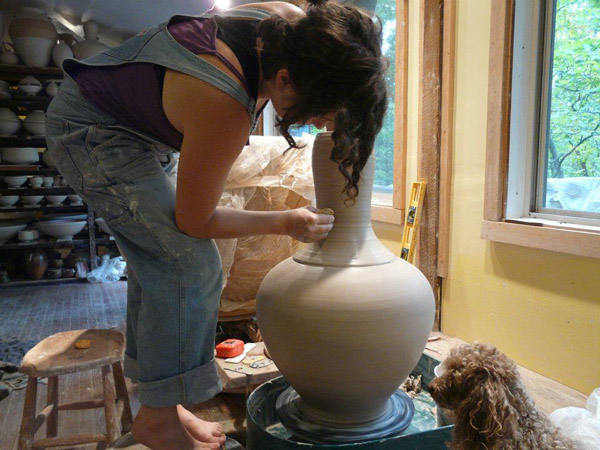
Artist Profile: Susannah Goodman
Ceramicist Susannah Goodman. All photos courtesy of the artist
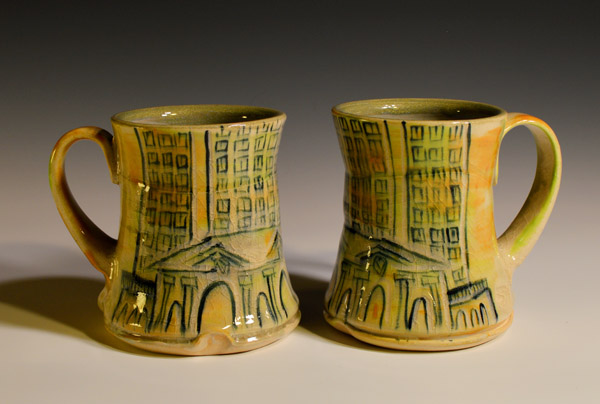
Train Station Mugs. All photos courtesy of the artist
Rosie Sharp: What brought you to ceramics initially? Has that changed over time?
Susannah Goodman: I have a distinct childhood memory of digging for worms in a friend’s yard. I remember pausing, analyzing the feeling of the not-quite-dirt as it squished between my fingers. It was a mysterious joy. Being dirty is something I always reveled in, and in that pocket of a memory, I remember feeling elated at the sticky smoothness of the earth. After high school, I attended Guilford College in Greensboro, North Carolina where I earned a BFA in Ceramics. North Carolina is the homeland of American pottery. From the Catawba peoples’ use of native clays to make grain storage jars, to the Moravian potters’ weaving of biblical morality tales into their slipware decorations, to the current lineage of traditional English-style salt-ware potters coming up throughout the state, North Carolina’s pottery scene is both traditional and contemporary. Studying there as an undergraduate student, I felt interwoven to that long thread of makers. Charlie Tefft was my mentor and advisor at Guilford, and he encouraged study of ceramic history as essential to a studio practice. He also got me hooked on the thrill of firing wood kilns.
After graduation I spent a year coordinating a set of art studios at a retreat center in Washington State, called Holden Village. I was able to both teach and learn loom weaving, basketry, bookbinding and printmaking, as well as manage the beautiful clay studio. From the full-load of classes I was responsible for teaching, I learned the potency of teaching as a tool for self-reflection. My students were my greatest inspiration, and continue to be.
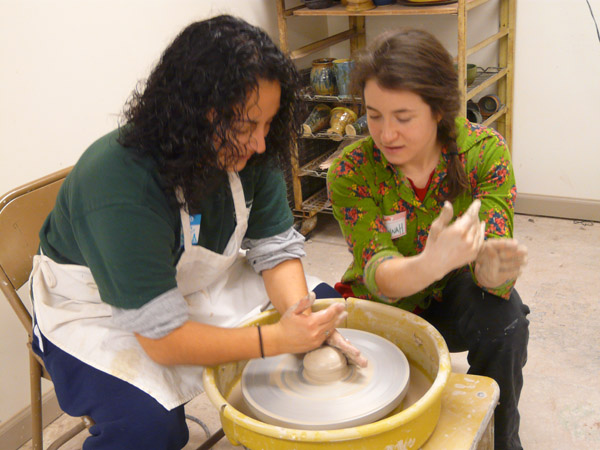
Goodman (right) at one of Ladybug Studios drop-in workshops. All photos courtesy of the artist
From 2010-2012 I was apprentice to a wood-fire potter in Virginia Named Kevin Crowe. Kevin has been described as a “traditional Japanese potter stranded in Appalachia,” and is an inspiring teacher. He leads a contemplative life, and one of intention. I recycled all his clay, mixed all the glazes, split and hauled wood and mopped floors. In exchange, I was able to make my own work in his studio and ask him as many questions as I could think of. No money exchanged hands in that relationship, but I was able to make a living as Artist in Residence at the nearby elementary school. There’s a motto painted on the doorway to Kevin’s hill-climbing anagama kiln (hole kiln, in Japanese): ‘Everything changes, everything is connected, pay attention.’ And also, ‘Hamba Gashle’ or ‘Go Slowly/Gently’ from a Zulu proverb. Along with clay skills I gained as apprentice, I carry these two benedictions through my life.
After the conclusion of my apprenticeship, I considered several residencies at clay centers around the country, but felt called to come home to this city I love. I’m proud to be a part of art scene of Detroit today. This community is welcoming, collaborative and supportive. I currently serve as the Studio Manager for a clay cooperative in Southwest Detroit, Ladybug Studios, where I make most of my work. I’ve worked for Pewabic Pottery in a number of teaching capacities, building networks within that vibrant community, as well. Outside of the clay world, I also serve as a Gallery Teacher at the Detroit Institute of Arts, helping students find personal meaning through art. For the last year, I’ve had the honor of serving on the Michigan Council for Arts and Cultural Affairs. As a councilperson, I sit on grant review panels, advise on and assist with outreach for the grant programs, and bring the needs of emerging artists to the table in Lansing when decisions are made about the distribution of tax dollars to arts and culture organizations statewide. I’m learning a lot about what goes into the funding of the arts nationwide.
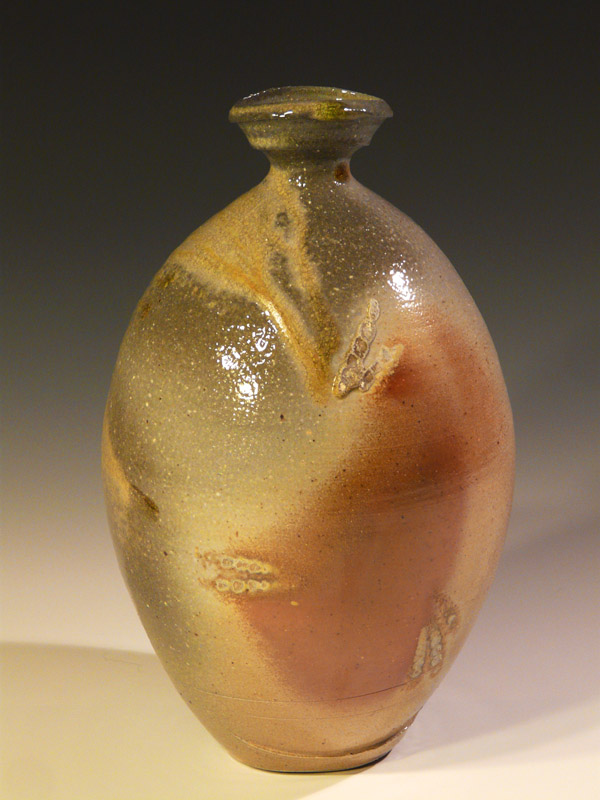
Crescent Bottle. All photos courtesy of the artist
RS: I’ve attended and greatly enjoyed the open sessions at Ladybug Studios. Talk a little about that collaborative workspace, if you like. Do you feel like teaching ceramics informs your own practice? Do you have any examples of surprising revelations that have arisen as a result of working with novice ceramicists?
SG: Ladybug was the first place I landed when I moved back to Detroit. My first experience in the space was attending one of the drop-ins, and I fell in love with the learner-centered approach to clay. Each participant can define their own experience, from just standing on the wall in observation, to exploring the wheel, to designing their own hand-built project – all without the souvenir mindset. The collaborative nature of the co-op is essential to the welcoming feeling during the drop-ins. Another thing that I love about Ladybug is the variety of skills and experiences co-op members offer to one another. I’m humbled by the generosity of time and spirit members give to the space, one another, and the community.
I’ve been teaching for Pewabic Pottery for the last few years – with students from preschool to retirement-aged. Teaching is a vital part of my experience with not just clay, but art making in general. For beginners, the joy of interacting with a new material as a beginner is thrilling, and I’m honored to be a part of it and inspired by it. My preschoolers, in particular, have inspired a recent line of work. The PNC Bank Grow Up Great program funds a preschool enrichment class that I’ve taught for the last two years in seven different classrooms around the city. Using clay to explore numbers and counting, letters and spelling, shapes and colors, the 4-year-olds revel in the tactile experience and the novelty of creation. When the clay slumps or tears, they squeal with surprise and excitement – that is the quality I’m now seeking with my work: the freedom to embrace the tears and stretch marks as a vital part of the exploration of clay. My most recent body of work is torn, broken, slumped and twisted, and the Detroit Public Schools Preschoolers have taught me to embrace those moments, those expressions of the nature of the clay.
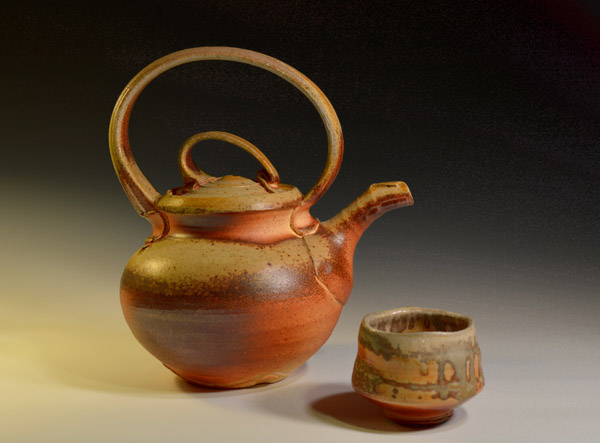
Teapot and Teabowl. All photos courtesy of the artist
RS: I happen to know you also work at the DIA. What role do you see ceramics playing in the wider fine art world? Is it well-represented in the DIA’s collection? Are there ways you wish ceramics were viewed differently within the fine arts?
SG: Ceramics, especially functional ceramics, has been marginalized by the fine art world for the last few centuries. Part of this distinction is rooted in function – does the object actually do something? In the contemporary art world, a platter is a work of craft. Now if you tear a hole in the center of the platter, negating its function, it’s a work of art. That leads us to another way to look at it is rooted in the notion of containment – does it hold something? In the traditional museum context, an oil painting is high art, and the frame holding it would be considered low art. There’s a bit of patriarchy in the debate, as well. Throughout history the traditional work of women has been defined in terms of its “decorative” qualities, discounting any aesthetic thought and artistry that went into the making of the object. The distinction between artist and artisan, designer and maker has similar implications of value. I’ve spent years of my life raging against these distinctions, certain of my position as both an artist and a maker. Knowing that I didn’t fit into any of the categories I studied, I grew to resent the categories themselves. At this point in my life, I’ve dismissed the idea that the distinctions confine me in any way, and am more curious about what they tell us about our societal values and ideas of worth.
The DIA’s collection of ceramics tells a different story. The DIA’s curators have done an excellent job of integrating the traditionally-labelled “decorative arts,” into the galleries with all the other works of the same eras and places. It was a somewhat radical choice at the time of the reinstallation in 2007, but like many of the decisions made at that time, has been a trendsetter nationally for gallery design.
My studies as Gallery Teacher have shined a light on a different theme in the history of clay – I’ve learned from the collection that clay is the foremost impersonator. In the world of the French aristocracy, bare porcelain was used to imitate sugar sculptures for fancy dining centerpieces. In late medieval Europe, tin-glazed earthenware was used to imitate marble architectural reliefs. In many Pre-Columbian Central American communities, mourning families would fill the tombs of their loved ones with earthenware replicas of everything one might need in the afterlife, from musical sham figurines to adorable pet dogs.
Thanks to Susannah for a lovely and thoughtful interview! You can catch up with her during drop-ins at Ladybug Studios and see more of her work here: susannahgoodman.com. Ladybug Studios: Whitdel Building, 1250 Hubbard St., Suite. B1; Detroit; ladybugstudios.wordpress.com
Recent Content
-
Artsarticle ·
-
Artsarticle ·
-
Artsarticle ·
